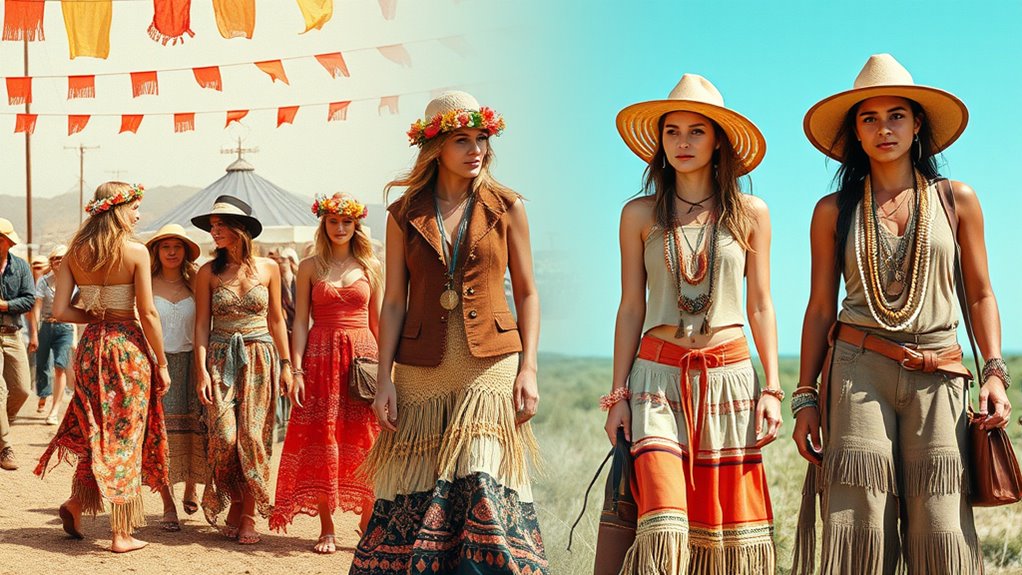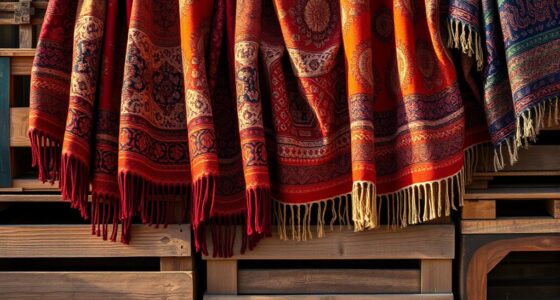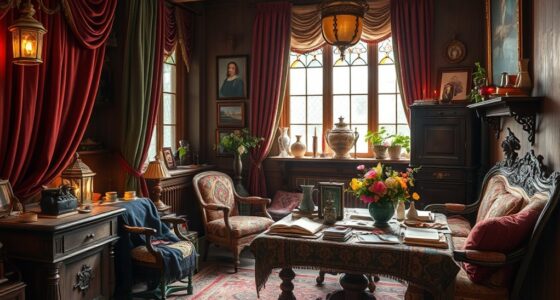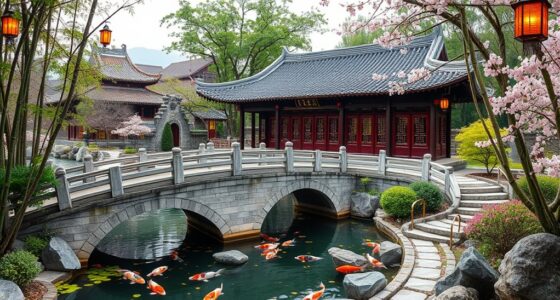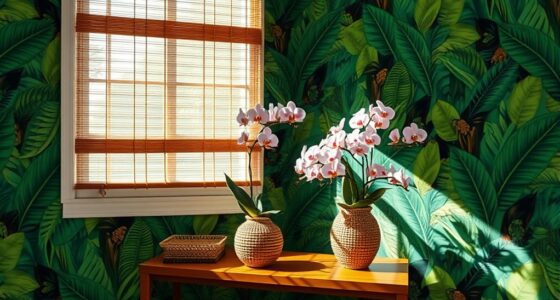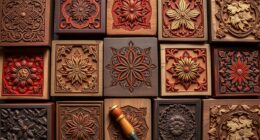The boho movement started in the 1960s as a counterculture style that emphasized comfort, individuality, and cultural diversity, drawing inspiration from global textiles and artisanal crafts. It evolved through the 70s and 80s with ethnic patterns and vintage accessories, then gained mainstream popularity in the 2000s thanks to celebrities. Today, it blends tradition with modern sustainable fashion and technology, staying true to its roots. To explore how it keeps transforming, keep going for more insights.
Key Takeaways
- The boho movement originated in 1960s counterculture, emphasizing individuality, comfort, and handcrafted vintage textiles inspired by global cultures.
- Artistic and musical influences, including vibrant art and indigenous motifs, shaped its eclectic aesthetic and layered textures over decades.
- During the 1970s and 1980s, boho textiles diversified with ethnic patterns, natural fibers, and vintage accessories, transitioning into mainstream fashion.
- Celebrities in the 2000s popularized boho style, blending vintage pieces with modern trends and expanding it into lifestyle and home decor.
- Today, boho evolves through sustainable practices, digital platforms, and cultural integration, maintaining core values of freedom and authenticity.
Origins in the Counterculture of the 1960s
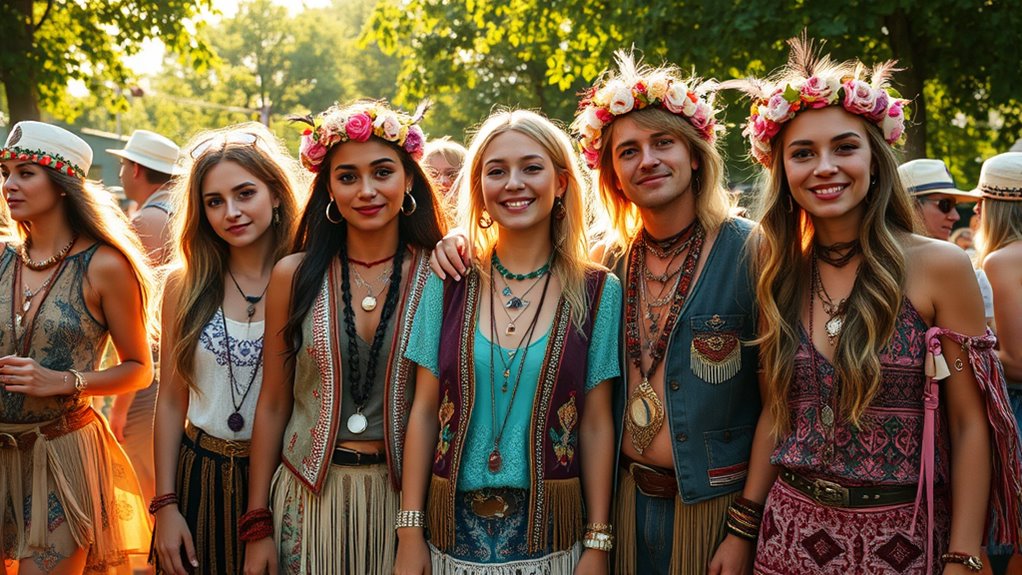
The Boho movement has its roots firmly planted in the counterculture of the 1960s, a time when young people challenged traditional values and sought alternative ways to express themselves. You’ll notice that hippie fashion played a central role, characterized by flowing skirts, fringed vests, and embroidered blouses. These styles emphasized comfort, individuality, and a rejection of mainstream fashion. Vintage textiles became essential, as people repurposed old fabrics to create unique, handcrafted clothing. This approach reflected a desire to break free from mass-produced garments and embrace authenticity. The movement celebrated a free-spirited attitude, blending elements from different cultures and eras, which laid the foundation for the bohemian aesthetic that continues today. Your style can trace its origins back to this rebellious, expressive era.
The Influence of Art and Music on Boho Style
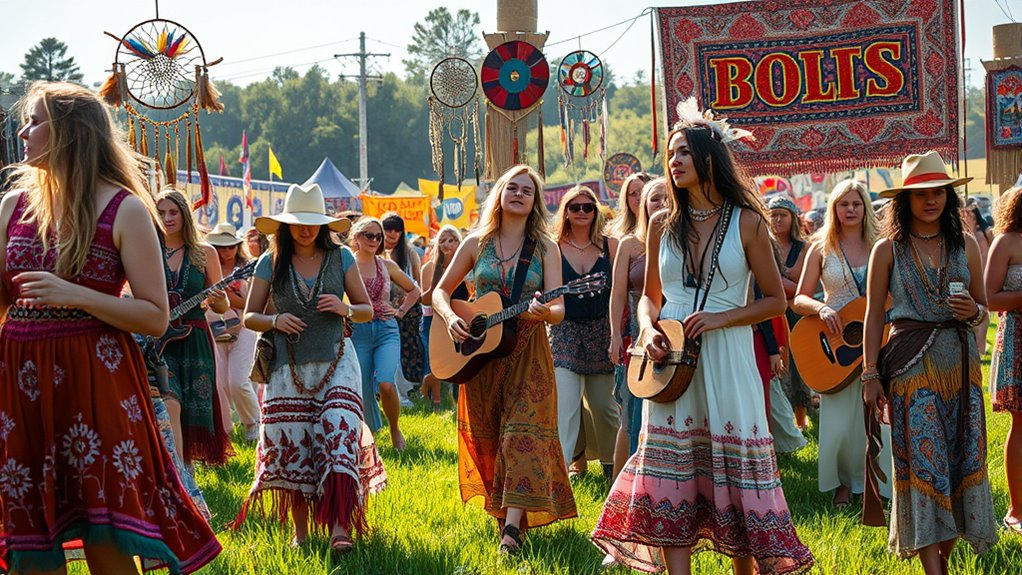
Art and music are at the heart of Boho style, shaping its unique look and feel. You can see their influence in the artistic inspirations that inspire its free-spirited vibe and the musical roots that echo in its laid-back attitude. Over time, the visual aesthetics of Boho have evolved, blending creativity and cultural expression seamlessly. Additionally, the movement’s history includes periods of disruption and recovery, much like how cybersecurity vulnerabilities can impact digital communities, reflecting its resilience and adaptability.
Artistic Inspirations in Boho
Since the Boho movement draws heavily from diverse artistic expressions, you can see how vibrant art and eclectic music have shaped its unique style. Artistic influences manifest through symbolic motifs that evoke meaning and emotion, often inspired by indigenous, tribal, or vintage art. The color palettes are diverse, blending earthy tones with bold, saturated hues to create a lively, layered aesthetic. To understand these influences better:
- You notice motifs like feathers, flowers, and geometric patterns woven into textiles and accessories.
- The color schemes often reflect natural landscapes—warm browns, sunset oranges, and lush greens.
- Artistic inspirations draw from bohemian painters and folk art, adding a handcrafted feel.
- Music’s vibrant energy influences visual elements, encouraging free-spirited, expressive designs.
- The color accuracy of visual representations enhances the authenticity of boho-inspired artworks and displays.
Musical Roots of Style
Music and art have long intertwined to shape the boho style, infusing it with a lively, free-spirited energy. The hippie movement popularized folk music, emphasizing authenticity and connection to nature, which directly influenced boho fashion. You might picture musicians strumming guitars under open skies or singing heartfelt lyrics that echo the movement’s ideals. This musical heritage encourages layering and natural textures in your wardrobe, reflecting the same free-flowing spirit. To visualize:
| Folk melodies echo | Peaceful, earthy tones |
|---|---|
| Acoustic guitars | Flowy skirts |
| Psychedelic vibes | Beaded jewelry |
| Harmonies blend | Dreamcatchers |
| Spontaneous jams | Loose, layered fabrics |
Understanding the musical roots of boho style helps to appreciate its authentic, laid-back aesthetic and its emphasis on natural, artistic expression.
Visual Aesthetics Evolution
The visual aesthetics of boho style have evolved through a dynamic interplay of art and music, shaping its distinctive, eclectic look. You notice how textile techniques like embroidery, patchwork, and fringe add texture and authenticity. The color palettes shift constantly, blending earthy tones with vibrant hues, reflecting cultural influences. To understand this evolution, consider these key points:
- Artistic movements inspired textile techniques, creating layered, handmade fabrics.
- Music’s influence introduced bold, expressive color palettes that evoke freedom.
- The fusion of traditional craftsmanship with modern styles enhanced the eclectic vibe.
- Visual elements like mixed patterns and artisanal details highlight the movement’s artistic roots.
This interplay continues to redefine boho aesthetics, blending history with contemporary flair.
Evolution Through the 1970s and 1980s
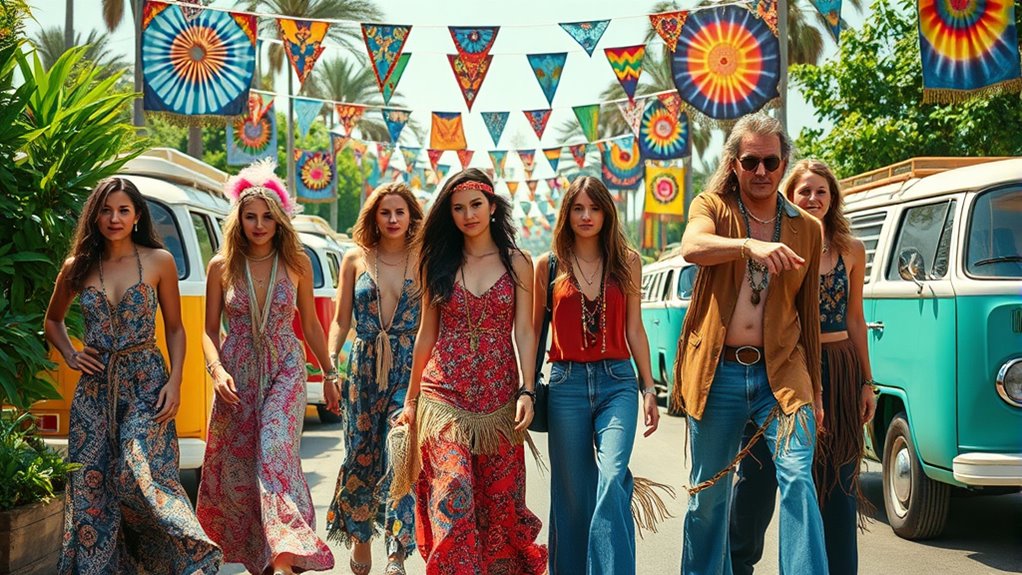
During the 1970s and 1980s, the boho movement experienced a significant transformation as it spread beyond its roots in the 1960s counterculture. You notice how bohemian textiles become more diverse, incorporating ethnic patterns and natural fibers, reflecting global influences. Vintage accessories, like layered jewelry and fringe bags, gain popularity, emphasizing individuality. This era sees boho styles move into mainstream fashion, blending comfort with artistic expression. Additionally, the adoption of boho aesthetics by designers helped solidify its place in contemporary style.
The Revival and Mainstream Adoption in the 2000s
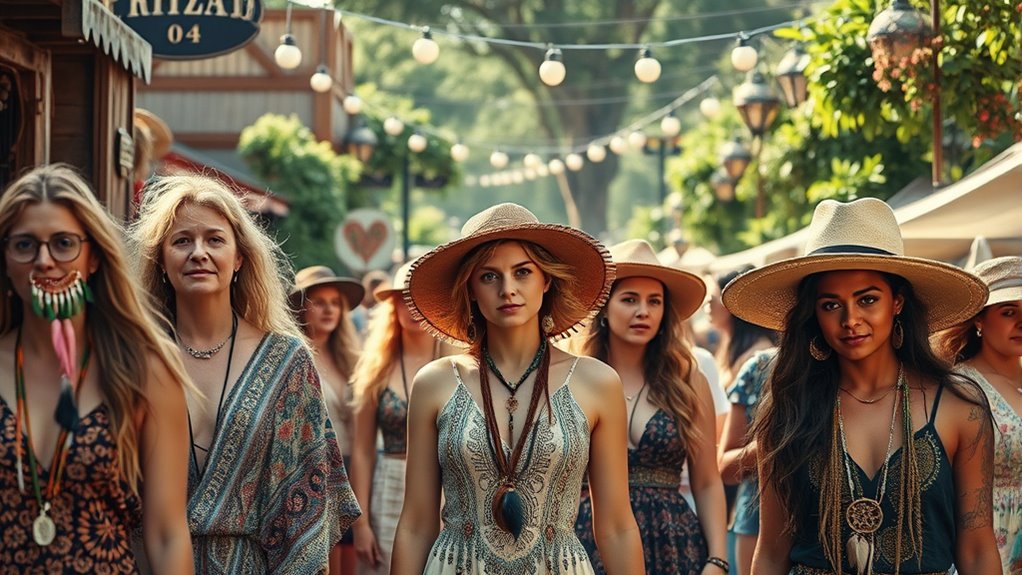
In the 2000s, celebrities start sporting boho styles, making the look more visible and desirable. As their influence grows, mainstream fashion brands begin incorporating boho elements into their collections. This shift helps the movement evolve from niche to widely embraced fashion. Additionally, the relationship between personal expression and fashion trends played a significant role in popularizing boho aesthetics, as individuals sought to showcase their unique identities through clothing.
Celebrity Influence Boosts Popularity
Celebrity influence played a pivotal role in revitalizing the boho movement, catapulting it into mainstream fashion in the 2000s. You saw stars embrace the style, making it more accessible and desirable. They popularized key elements like:
- Layered boho jewelry, often featuring chunky, handcrafted pieces
- Flowy dresses made from natural fabrics that emphasize comfort and sustainability
- Accessories like wide-brim hats and fringe bags that added a free-spirited vibe
- Mixing vintage and modern pieces to create an effortless, personalized look
These celebrities showcased boho fashion on red carpets and magazine covers, inspiring fans worldwide. Their influence turned boho from a counterculture statement into a mainstream style that celebrates individuality and natural beauty. Additionally, the adoption of fashion trends by celebrities helped solidify boho’s place in contemporary style.
Fashion Industry Embraces Boho
As boho gained popularity in the 2000s, the fashion industry avidly embraced its free-spirited aesthetic, transforming it from niche trend to mainstream phenomenon. You’ll notice boho jewelry becoming a staple in every wardrobe, with layered necklaces, fringe earrings, and earthy tones. Designers started incorporating boho elements into clothing lines, blending relaxed fabrics with vintage-inspired patterns. The movement also influenced home decor, as boho home decor gained popularity, featuring eclectic textiles, woven wall hangings, and colorful rugs. Retailers began offering collections that celebrate this carefree style, making boho accessible to everyone. This mainstream adoption helped solidify boho as a versatile look, blending fashion and home decor to evoke a sense of effortless individuality and artistic expression. Additionally, the cultural influences behind boho style highlight its roots in diverse artistic traditions, further enriching its appeal.
Cultural Blending and Global Inspirations
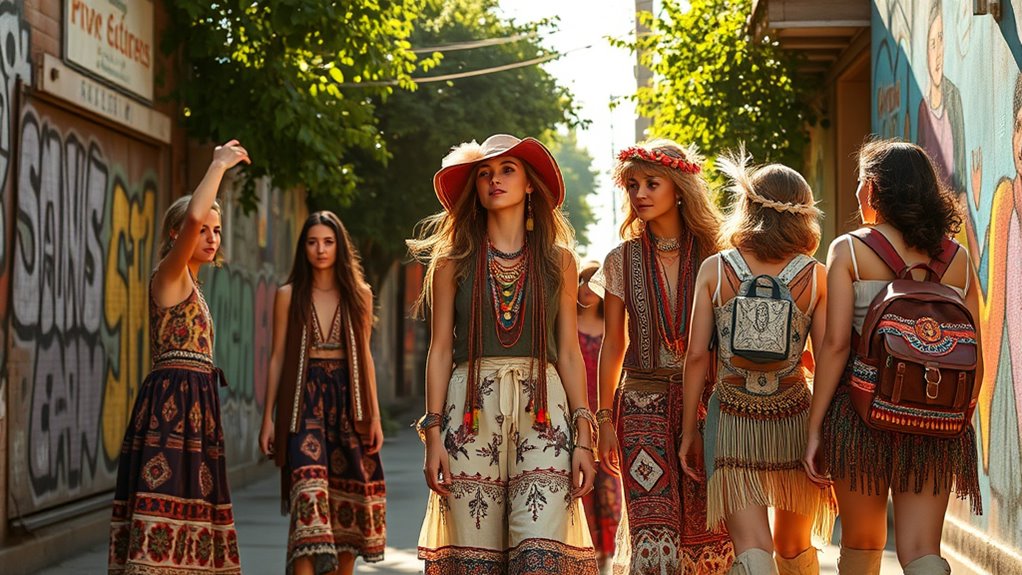
The Boho movement thrives on a rich tapestry of cultural blending, drawing inspiration from diverse traditions around the world. You’ll notice this in the use of ethnic textiles that add vibrant patterns and textures. Handcrafted jewelry also plays a key role, showcasing artisanal skills from various cultures. To deepen your understanding, consider these aspects:
Embrace global traditions through vibrant textiles and artisanal jewelry that celebrate cultural diversity and craftsmanship.
- Incorporation of traditional fabrics from India, Africa, and South America
- Mixing of bohemian styles with indigenous patterns
- Use of handcrafted jewelry to symbolize cultural stories
- Fusion of global influences into modern fashion statements
- The movement’s emphasis on authenticity and craftsmanship, celebrating the beauty of global traditions.
This blending creates a unique, eclectic aesthetic that celebrates cultural diversity. You become part of a movement that values authenticity, craftsmanship, and the beauty of global traditions.
Modern Interpretations and Trends
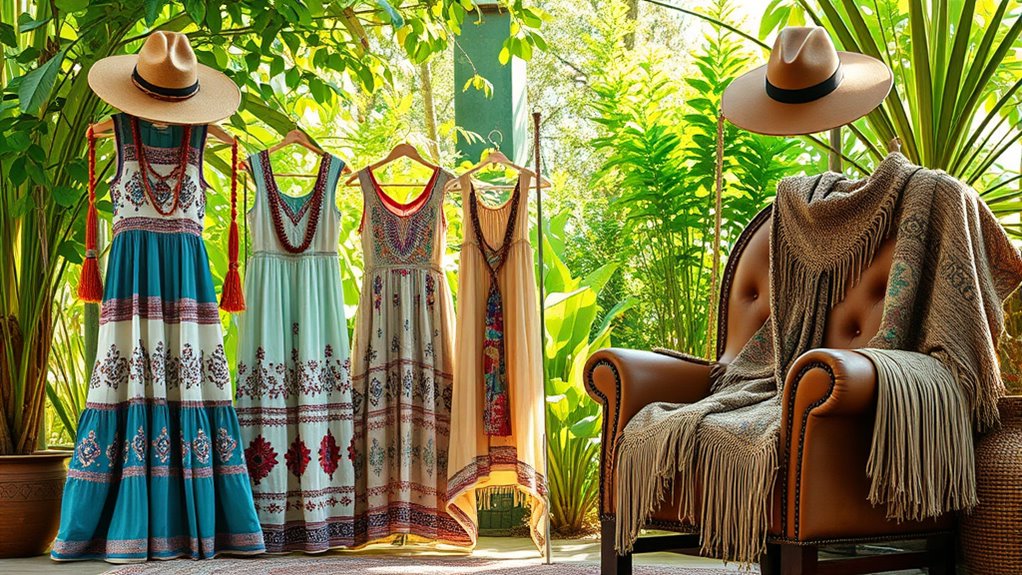
Modern interpretations of the Boho movement continue to evolve, blending its traditional roots with contemporary fashion trends. Today, you’ll see a focus on sustainable fabrics, such as organic cotton, hemp, and recycled materials, emphasizing eco-conscious choices. Minimalist designs have gained popularity, offering streamlined silhouettes that highlight quality and craftsmanship without excess ornamentation. This approach reflects a shift towards simplicity while maintaining the free-spirited essence of Boho. Fashion enthusiasts often combine these modern elements with vintage pieces, creating a look that’s both fresh and rooted in history. By prioritizing sustainability and minimalism, current trends honor the movement’s origins while adapting to today’s ethical and aesthetic standards. Additionally, ethical fashion practices are increasingly integrated into Boho-inspired styles, emphasizing fair trade and environmentally responsible production. This ongoing evolution keeps Boho relevant and accessible for a new generation.
The Future of the Boho Movement
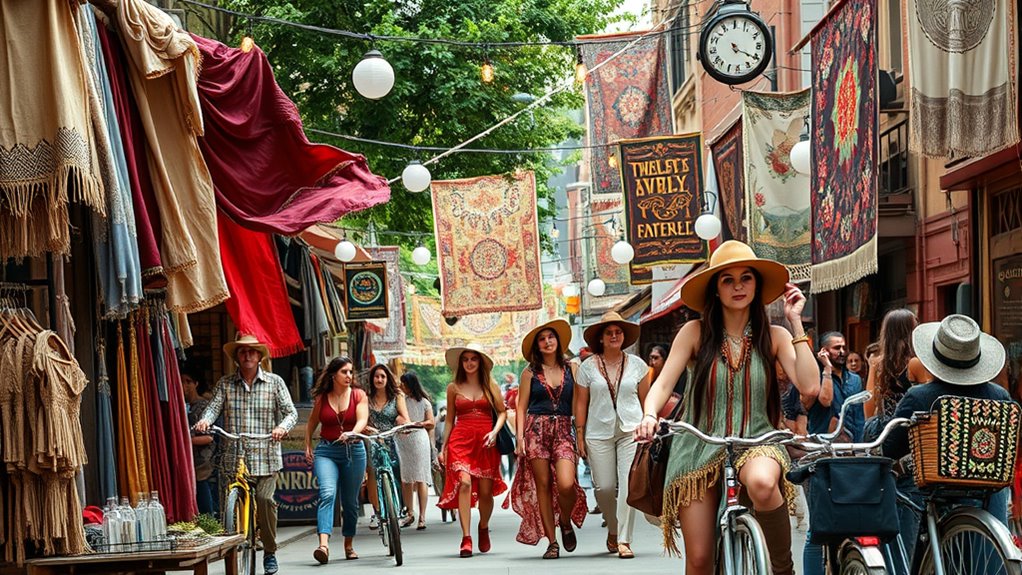
Looking ahead, the Boho movement is poised to evolve by embracing new technologies and global influences that expand its reach and relevance. You’ll see sustainable fashion becoming central, with brands prioritizing eco-friendly materials and ethical production. Digital influence will play a key role, helping you access diverse styles and connect with a worldwide community. To stay ahead, expect:
- Increased online platforms showcasing authentic boho designs
- Greater emphasis on eco-conscious materials and practices
- Virtual events and fashion shows offering immersive experiences
- Influencers promoting sustainable, globally inspired boho aesthetics
- Incorporation of Law of Attraction principles to inspire personal expression and attract like-minded communities.
This future keeps the spirit of freedom and individuality alive while adapting to modern values and innovations. The movement’s evolution will deepen its cultural impact and sustainability focus, making it more relevant than ever.
Frequently Asked Questions
How Did Boho Fashion Influence Mainstream Clothing Brands?
You can see how boho fashion influence has shaped mainstream clothing brands by incorporating its relaxed, eclectic styles into everyday wear. Mainstream brands integrate boho elements like flowy fabrics, fringe, and earthy tones to appeal to a wider audience. This fusion creates versatile, trendy pieces that reflect boho’s free-spirited vibe, making boho fashion influence a staple in modern fashion collections.
What Role Did Specific Artists Shape Boho Aesthetics?
You see, hippie icons like Janis Joplin and Jimi Hendrix, along with boho icons like Janis Joplin and Stevie Nicks, shape boho aesthetics by embodying free-spiritedness and eclectic style. Their bold, relaxed looks inspire you to embrace flowing fabrics, earthy tones, and layered accessories. These artists’ unique expressions of individuality and bohemian spirit have helped define and popularize boho fashion, influencing both mainstream trends and personal style choices.
Are There Regional Variations of Boho Style Worldwide?
Imagine a tapestry woven with diverse threads—each regional variation of boho style reflects unique cultural influences. You’ll find that boho in India blends vibrant textiles and intricate embroidery, while in Morocco, it’s inspired by desert hues and handcrafted jewelry. These regional diversity elements shape the boho aesthetic worldwide, making it a dynamic, ever-evolving expression of cultural identity. Embracing these influences, you create a style that’s rich, authentic, and globally connected.
How Has Social Media Impacted Boho Trends Recently?
Social media influence has markedly shaped boho trends recently by making digital fashion trends more accessible and widespread. You can easily discover new boho styles, share your looks, and follow influencers who popularize the aesthetic. Platforms like Instagram and TikTok accelerate trend cycles, allowing you to stay current with the latest boho fashion. This digital exposure encourages individual creativity, making boho style more diverse and personalized than ever before.
What Sustainable Practices Are Associated With Modern Boho Fashion?
Think of the boho spirit echoing through nature’s harmony. You embrace sustainable practices by choosing recycled fabrics, reducing waste while staying stylish. Ethical sourcing guides your choices, ensuring fair labor and eco-friendly materials. By supporting brands that prioritize these practices, you embody the conscious and free-spirited essence of modern boho fashion, turning your wardrobe into a statement of harmony with the earth and respect for its resources.
Conclusion
As you explore the boho movement’s rich history, it’s amazing to see how it’s grown from a counterculture rebellion into a global fashion statement. Today, over 60% of people worldwide embrace boho-inspired styles, blending cultures and eras effortlessly. Whether you’re drawn to its artistic roots or modern reinterpretations, the boho movement invites you to express your individuality freely. Embrace its evolving spirit and make it your own—after all, that’s what it’s all about.

